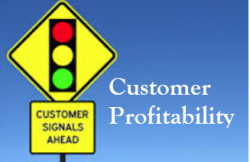Using Business Intelligence to Determine Customer Profitability
 Can you answer these three questions about your customer base right now?
Can you answer these three questions about your customer base right now?
How many of your customers are unprofitable?
Why are those customers unprofitable?
Who are your top 10 most profitable customers?
Businesses need to keep a tight eye on their finances. But knowing your finances means so much more than counting pennies in and out. Basic bookkeeping won’t tell you where the opportunities to cut costs lie; how much you are truly spending to acquire new customers, or why you are losing money on product X.
For example, one recent industry study found that a company loses $500,000 in revenue for every 1% of customers it loses. That means keeping current customers happy might be worth more than acquiring new customers, especially if it costs more than $500k to grow your customer base by 1%. But the only way you could uncover that valuable insight is if you have business intelligence software working in the background. With a business intelligence software system in place you can determine true customer profitability to maximize profit and cut spending in areas that don’t deliver.
The Role of Data in Customer Profitability Analysis
The reason that many companies find it challenging to improve customer profitability is that the customer-detailed information they need is buried in transactional databases. If all a company does with its customers is manage the accounts receivables, and all it focuses on is overall customer profitability as reinforced by high level, general ledger (GL)-based performance measures, it is missing important strategic opportunities to manage customer profitability and to increase the lifetime economic value of its customers.
Customer profitability analysis must be driven from data that’s been extracted from financial and transactional systems and easily organized into a customer-centric data warehouse or repository. Then, key performance metrics system can be applied to the data to help replace the often erroneous impressions, guesses, or hunches about the relative profitability of your customers with more objective information related to:
- Lifetime revenue contribution
- Discount impact
- Net profitability
- Customer performance by month
- Channel profitability
- Customer trends
- RFM frequency
The Value of Having Access to Customer Profitability Info
Armed with new information about customer profits, managers can then focus on appropriate actions related to profitable customer retention and acquisition, making unprofitable customers profitable and reducing or eliminating profit erosion resulting from customers who destroy shareholder value.
The objective is to build marketing and retention programs for customers that display profitable characteristics and to look at re-pricing, re-packaging, or other operational or pricing strategies to turn unprofitable customers into profitable customers.
Most importantly, the ability to analyze and manage customer profitability fosters a better understanding throughout the organization of the relationship between customer behavior and customer profitability as well as how customer profitability is impacted by the way the organization responds to customer behavior.
It may not be profitable to hang onto every customer. But, the customer intelligence that a business intelligence system can provide can help you ensure that your most profitable clients remain satisfied and your sales and marketing efforts are aimed at retaining and optimizing the right customers.